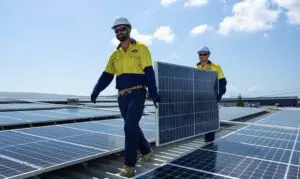South Australia – now generating more than 50 per cent of its electricity needs from wind and solar – is an example to the rest of Australia, and the world, on how grids can move beyond “baseload” and transition to low emissions grid dominated by renewables.
Or, to put it another way, South Australia’s grid provides real world evidence of how a new base load generator, such as the nuclear power station some in the Coalition are so keen on building, would now be impossible to incorporate into a system with high levels of variable renewable generation.
That is the key message from the latest National Energy Emissions Audit from The Australia institute: South Australia is past the point of return to new baseload generation, and the world – and the federal government of Australia – should take note.
The report, authored by Hugh Saddler, notes that for nine of the last 18 months, half of all electricity supplied in S.A. has been from renewable generators, including rooftop solar.
 This renewable generation has at times been enough to meet all of the state’s energy demand and – as AEMO has acknowledged – will be able to gradually reduce market interventions such as directing gas generators to run as more synchronous condensers come on line.
This renewable generation has at times been enough to meet all of the state’s energy demand and – as AEMO has acknowledged – will be able to gradually reduce market interventions such as directing gas generators to run as more synchronous condensers come on line.
“South Australia is showing Australia and the rest of the world how best to integrate new generation on a large scale,” says Saddler.
“The inter-connector between South Australia and Victoria was completed more than 30 years ago, and since then South Australia has almost always been a net importer of electricity from Victoria. (As revealed in the graph above).
“Now, thanks to its strong renewables leadership and uptake, it is a net exporter of electricity to Victoria for most months of the year.”
 These graphs show the transition in South Australia over the last 20 years. First in capacity (above), and then in sent out generation (below). Brown coal has disappeared, effectively replaced by wind and solar.
These graphs show the transition in South Australia over the last 20 years. First in capacity (above), and then in sent out generation (below). Brown coal has disappeared, effectively replaced by wind and solar.
The amount of gas capacity has changed little over that period, and neither has the amount of gas generation. The state is, however, now a net exporter rather than importer of electricity.
Wholesale prices have also jumped, but would have anyway given the big rise in the cost of gas generation, although prices have fallen significantly over the past couple of months due to the high output of renewables, which points to what can be expected as this becomes a feature across the year.
Interestingly, in light of the recent push by some Coalition MPs to cut Queensland off from the rest of the grid, the report traces the history of the South Australia network, and its push to have the inter-connector built to Victoria in the 1980s after a mistake by a gas supplier resulted in the shut-down of the main gas generator and a state-wide blackout in June, 1980.
The TAI report says the amount of variable renewables in the grid demonstrates “how technically and economically difficult – if not impossible – it would be to use generation technology that must operate continuously,” such as new coal or nuclear.
But of course, this is not the message we are getting from federal politicians, who – like federal energy minister Angus Taylor – continue to deride technologies like wind energy generation as “intermittent,” and to call for “24/7” and “baseload” generation like coal and nuclear, as if these were the missing links to a stable and cost-efficient future grid.
At least the Liberal government in South Australia understands the assets at its disposal, and is now forging a path towards “net 100 per cent renewables” that it expects to reach before 2030 and become an even greater exporter of renewable energy to the eastern states.
“South Australia’s world leading position, as recognised by the International Energy Agency’s World Energy Outlook last year, is still to be acknowledged by Australia’s policy makers,” Saddler goes on to say.
“Australia can quickly and affordably transition to renewables and storage, as demonstrated by South Australia, but investigations into so-called baseload energy, like nuclear, are a complete distraction by government.”
This is illustrated in TAI’s report in the chart below, which shows a trading interval residual load duration curve for South Australia during July.
As the report explains, residual load is the consumer demand for which, at a certain point in time, there is insufficient renewable generation – meaning supply had to come from either gas generators or imports form Victoria.
What the curve shows is that in July during 88 trading intervals (44 hours in total), all demand in the state could be supplied by its current levels of wind and solar, with some left over to export.
What was the “base load” in South Australia during July? The answer, says the report, is that there was no baseload – “and there never will be again.”
“Eliminating ‘base load’ is what the transition to a low emission renewable generation based electricity supply system is doing,” the report says; “in South Australia, in the rest of Australia, and round the world.
“The complement to variable renewable generation is not so-called “base load” generation (a meaningless term), but energy storage in some of its many forms and spatial/climatic diversification of renewable generation.”










